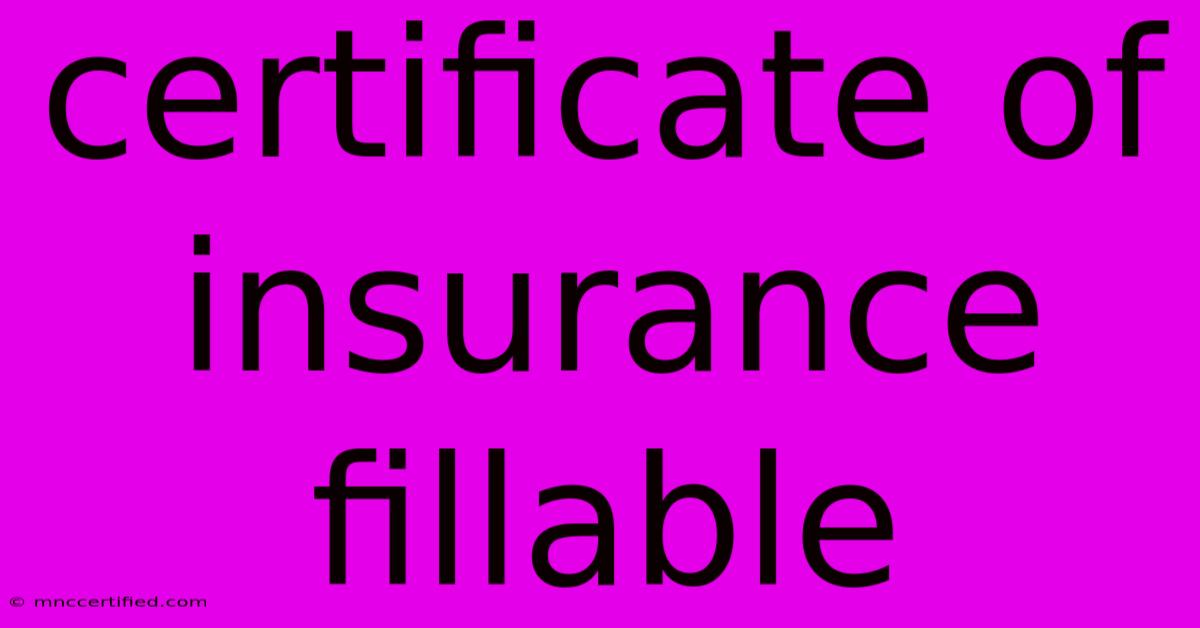Certificate Of Insurance Fillable

Table of Contents
Certificate of Insurance Fillable: A Complete Guide
Finding a reliable fillable certificate of insurance (COI) can be a time-saver for businesses and individuals alike. This guide will walk you through everything you need to know about fillable COIs, from understanding their purpose to finding the best options and avoiding common pitfalls.
What is a Certificate of Insurance (COI)?
A Certificate of Insurance, or COI, is not insurance itself; it's a document that verifies that you have insurance coverage. It acts as proof to third parties, such as clients, landlords, or event organizers, that you possess the necessary liability insurance or other coverage. Think of it as an official summary of your insurance policy's key details. Crucially, it doesn't replace your actual insurance policy.
Key Information Included in a COI:
- Insured's Name and Address: Your company or personal information.
- Insurance Company Name and Address: The provider of your insurance.
- Policy Number: Unique identifier for your insurance policy.
- Policy Effective and Expiration Dates: The period your coverage is active.
- Type of Insurance: Specifies the coverage type (e.g., General Liability, Workers' Compensation, Auto Liability).
- Limits of Liability: The maximum amount your insurance company will pay for covered losses.
- Additional Insured (if applicable): Parties who are added to your policy for coverage purposes.
Why Use a Fillable Certificate of Insurance?
Using a fillable COI form offers numerous advantages:
- Speed and Efficiency: Eliminates the need for manual data entry, saving significant time.
- Accuracy: Reduces the risk of errors associated with manual typing.
- Organization: Keeps all your COI information in one easily accessible place.
- Cost Savings: Reduces administrative overhead and potential printing costs.
Finding the Right Fillable COI Form
Several options exist for obtaining a fillable COI:
- Your Insurance Provider: Most insurance companies offer downloadable COI templates or online portals where you can generate a fillable form directly from your policy information. This is often the most reliable method.
- Online Templates: Numerous websites offer free or paid fillable COI templates in various formats (PDF, Word). Carefully review these for accuracy and compliance before use. Ensure the template accurately reflects the necessary legal requirements.
- Insurance Broker: If you work with an insurance broker, they can often provide you with fillable COIs or assist in generating them.
Common Mistakes to Avoid When Using Fillable COIs
- Inaccurate Information: Double-check all information for accuracy before submitting. Errors can lead to delays or even invalidate your COI.
- Using Outdated Templates: Ensure your template includes all the necessary information and complies with current regulations.
- Ignoring Specific Requirements: Some clients or venues may have specific requirements for COIs. Always check their specifications before submitting.
- Submitting an Incomplete COI: A missing piece of information can delay project start or even cause contract breach.
Best Practices for Using Fillable COIs
- Save a Master Copy: Maintain a digital and/or physical copy of your completed COI for your records.
- Update Regularly: Ensure your COI reflects current coverage information, especially near policy renewal dates.
- Seek Legal Advice When Necessary: If you have questions or concerns about COI requirements, consult with an insurance professional or legal advisor.
Beyond the Fillable Form: Strengthening Your Insurance Profile
While a fillable COI is a crucial tool, remember that a strong insurance profile goes beyond simply having a readily available form. Regularly review your insurance needs, ensure adequate coverage limits, and maintain good communication with your insurance provider. This proactive approach protects your business and enhances your credibility with clients and partners.
By following these guidelines, you can effectively utilize fillable certificates of insurance and manage your insurance documentation efficiently. Remember, a well-maintained insurance profile is essential for safeguarding your interests and building trust with others.

Thank you for visiting our website wich cover about Certificate Of Insurance Fillable. We hope the information provided has been useful to you. Feel free to contact us if you have any questions or need further assistance. See you next time and dont miss to bookmark.
Featured Posts
-
Clean Sweep Australia Defeats Pakistan
Nov 19, 2024
-
Guy Dean Insurance Alden Michigan
Nov 19, 2024
-
Errors And Omissions Insurance Nc
Nov 19, 2024
-
Scotland 2 1 Poland Nations League Report
Nov 19, 2024
-
Tuchels Impact A New Coaching Era
Nov 19, 2024